Final Paper
It seems these days no matter where you turn there is always some kind of promotion encouraging the public to be green. Whether you are at the grocery store in an entire section of Eco-friendly products and locally grown foods or you are next to a hybrid vehicle on the road, the concept of green is everywhere. We as consumers are left to decide to what extent we choose to be responsible for reducing what seems to be the Earth's inevitable deterioration. But how is it possible to distinguish which products are truly environmentally safe versus the products that only claim to be green? It is precisely this question for which I chose to write about this topic. Throughout my research, there are three different aspects of green marketing that are consistently mentioned: marketers and advertisements are not as green as they portray themselves to be, the overall business of advertising environmental values is an oxymoron, and the depiction of nature in advertising disconnects the public from what should truly be valued by encouraging a reconnection through products and commodifying the natural world from non-material goods to material and possessible values.
To begin, consumers should recognize and understand that not all marketers and advertisements are trustworthy, and Green Marketing is no exception. Green Marketing, coined to "describe marketers' attempts to develop strategies targeting the 'environmental consumer,'" (McDaniel 1993) became particularly popular during the 1980's when a revitalized environmental movement helped establish environmentalism as a legitimate, mainstream public goal (Corbett, 83). As a result, marketers began to produce new products and services in addition to revamping previously existing products to have the appearance of being environmentally friendly (Corbett, 83). Now, thirty years later, companies are still producing what they claim to be environmentally friendly products. However several researchers agree that the reality is only 2% of all green products actually live up to their claims (Scheer, 2011). The remaining 98% of self proclaimed green products are committing what is known as Greenwashing: "the act of misleading consumers regarding the environmental practices of a company or the environmental benefits of a product or service." (Murray, 2011). These false claims made by companies and brands are guilty of one or more of the 'seven sins of greenwashing' (Murray, 2011). These seven sins are: hidden trade-off, no proof, vagueness, fakery, irrelevance, lesser of two evils, and fibbing (Bauers, 2011). Focused on consumer marketing and positioning, Greenwashing is so frowned upon because it wears away consumer confidence while diminishing the values of legitimate environmental success (Kaplan, 2011). Because businesses and companies see the color green as a reference to money, consumers need to analyze manufactured goods carefully in order to determine if the product is sincerely "green." According to an article published in The Environmental Magazine in 2009, the only good news is that "the growing availability of green products shows that consumers are demanding more environmentally responsible choices and that marketers and manufacturers are listening" (Scheer, 2011).
Although only 2% of products that are marketed as green truly are environmentally friendly, the overall business of advertising environmental values is an oxymoron. By nature advertising and green marketing are inherently opposite. Aiming to sustain capitalism and support continual increased production (Corbett, 87), advertising announces and praises different products or services in some public medium of communication in order to persuade people to buy or use it. Oppositely, the concept of environmentalism and green marketing is to recognize that continuous growth and consumption are inherently flawed (Corbett, 87). Green marketing aims to claim virtue and according to John Grant in his book The Green Marketing Manifesto, "selling and virtue don't mix" (Grant, 2011). It is therefore impossible to communicate the green message through normal marketing and also irrelevant that a product boasts about its recyclability or quietly features pristine mountain ranges in the background because, according to A Faint Green Sell: Advertising and the Natural World, "the basic business of advertising is brown [and] the only green products [are] not only one not produced, but also one not advertised" (Corbett, 87). Nonetheless, marketers and advertisements are still bound to comply to the desires and wants of consumers regardless of the contradictions in selling green values. While it is estimated that 70% of the U.S. population expressed environmental concerns, only 50% said they would make green purchases due to conflicts such as price, quality, effectiveness, availability, and convenience (Wasik, 2011). When making a green choice to purchase, customers want a product that is better for the environment but also fits their current lifestyle (McDaniel, 1993). Consequently, it is therefore meaningless as to what the product is and how green the advertisement claims the product to be because the goal and message will always be the same: "consuming is good, more is better, and the ecological cost is minimal" (Corbett, 87).
Lastly, the depiction of nature in advertising disconnects the public from what should truly be valued. With several technique likes creating evocative graphics that demand attention to using short clean paragraphs with lots of white space in between, marketers have been able to master the kinds of features that attract the largest amount of consumers (Byrnes, 2011). Since the 1980's marketers and advertisers have expanded from only promoting products that are environmentally friendly to using nature as backdrops or stages. Today, advertisers and marketers rely heavily on an infinite amount of natural features such as wild animals, mountains, vistas, and rivers to display qualities and features of the non-human world and our relationship to it (Corbett, 84). The result? These ads can gradually mold our values into becoming social guides for what is really important. The natural world is full of cultural meanings that we associate with products which then commodifies values to characteristics of the natural world which are, in reality, impossible to own (Corbett 87). By commidifying natural values in products consumers are falsely lead into believing their problems and dissatisfactions can be solved with the purchase of naturalistic products (Corbett, 89). This strategy of associating material goods with nonmaterial qualities functions to market feelings, sensations, and lifestyles by giving the consumer a sense of connection to different aspects of nature and different areas of the world when in reality they have little to no contact with the environment (Corbett 88). Linking social and personal meanings to objects persuades consumers to view products as more desirable due to the buyers current lack of "the wild" missing in day to day life (Corbett, 88). The effects of this kind of marketing and advertising is very evident in today's society and creates a cycle due to advertising ability to stimulate additional desires in consumers and its ability to induce changes in habits (Corbett, 92). In summary, advertising promotes products to be simple, possessible solutions to the everyday problems of consumers by diving into dissatisfactions and attempting to solve them by satisfying consumers desires. Nonetheless, this very tactic that leads consumers to buy these products only increases the feeling of disconnection from the natural world (Corbett, 93).
In conclusion, there are several different aspects of green marketing that are inconsistent with the true meaning of being environmentally friendly. First, marketers and advertisements in the media are not as green as they potray themselves to be. This results in 98% of the media committing what is known as Greenwashing, "the act of misleading consumers regarding the environmental practices of a company or the environmental benefits of a product or service" (Murray, 2011). Secondly, the entire concept of advertising environmental values and products is an oxymoron. Advertising, which aims to increase sales and sell as many products as possible, is completely opposite of the values and virtues of green marketing. Therefore, it is impossible to communicate green messages through normal marketing. Lastly, the depiction of nature in the media disconnects the public from what should truly be valued. By associating typical products with non-material, naturalistic qualities, advertising encourages consumers to reconnect to the natural world through products which leads to an even larger sense of separation from nature.
Creative Experiment
For my creative experiment, I chose to perform two different experiments to demonstrate the relationship between Green Marketing and consumers. For my first experiment, I accompanied Diana and David Skidmore who are close family friends to Publix. I chose to observe this couple because I knew that Diana was very selective when it comes to the food she eats. Knowing Diana prefers more healthier and natural products, I thought she would be the perfect candidate to follow in a grocery store to see just how knowledgeable she was about the seemingly "healthy" and "natural" products that she was buying.
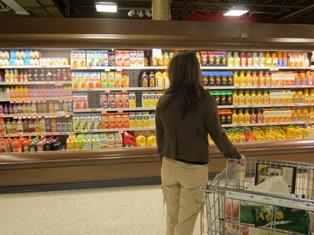
Upon entering, Diana and her husband immediately split up when they arrived to the produce section. As Diana picked up items like tomatoes, plantains, and fruits, she explained to me that she liked to buy fresh products that would be enough to last her only a few days. However, the only product she picked up that was organic was an Earthbound Farm Organic lettuce. As you can see below the product may be approved by the USDA but the packaging is still in an unfriendly packaging: plastic. In addition, on this particular week this brand of lettuce was on sale which coincidentally convinced Diana to purchase not one but two different Earthbound Farm packages. This is an excellent example of how green marketing (promoting organic foods) contrasts to the goals of advertising.
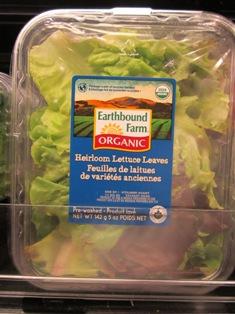

As we continued on, Diana had a wide arrangement of products. For each product she would explain why she chose what she selected. For example, as she picked out different flavored juices by Tropicana, she told me as she looked over the nutrition facts that she "didn't like additional sugars added inside the beverage" and when she was scanning over the different types of bacon, she said she looked for the package that had strips of meat with the least amount of white. Although these sounded like reasonable characteristics to look for, both products she chose were not organic. In fact, after spending almost a hundred dollars at the grocery store, Diana and her husband combined only bought four more organic products: Rice Dream Drink, which is similar to milk, Bear Naked Pure & Natural Granola, organic eggs, and Kalona Super Natural Yogurt.
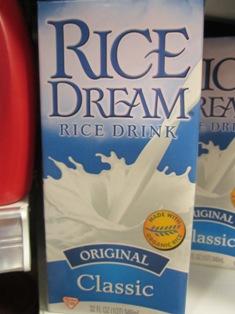
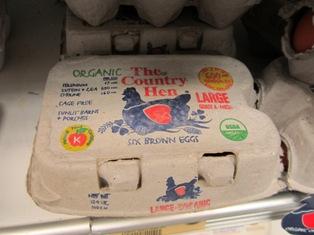
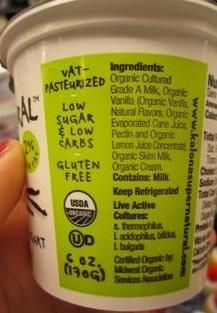
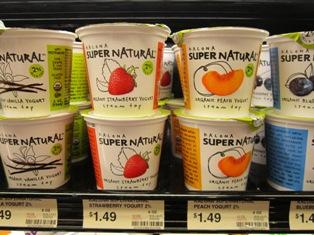
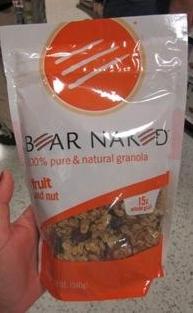
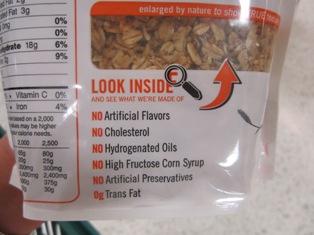
As Diana and David Skidmore continued through the aisles, there was one area that stood out to me. In the diary section of Publix, there were large gaps where cartons and gallons of milk should have been. In their place was this sign:
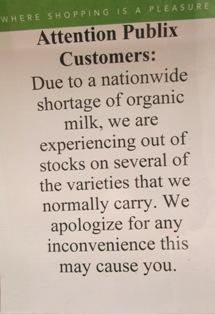
Overall, joining the Skidmore's during their grocery shopping lead me to think even more deeply about consumers and their choices of green products, specifically with groceries and organic products. Initially I had chosen to observe the Skidmore's because Diana was so selective and particular with the foods she ate. When asked, Diana claimed that she made healthy organic and environmentally friendly choices when she went grocery shopping. However when I accompanied her at Publix, she made only a handful of organic choices while the rest of the products were either processed or in non-ecofriendly packaging. This lead me to question how informed consumers really are about the products that they buy. Do consumers know what the true meaning of organic is and can they tell which products are reliable versus the products that commit greenwashing? These questions lead me to create a survey to see just how knowledgeable consumers are in the green market.
Experiment 2
Survey and Results
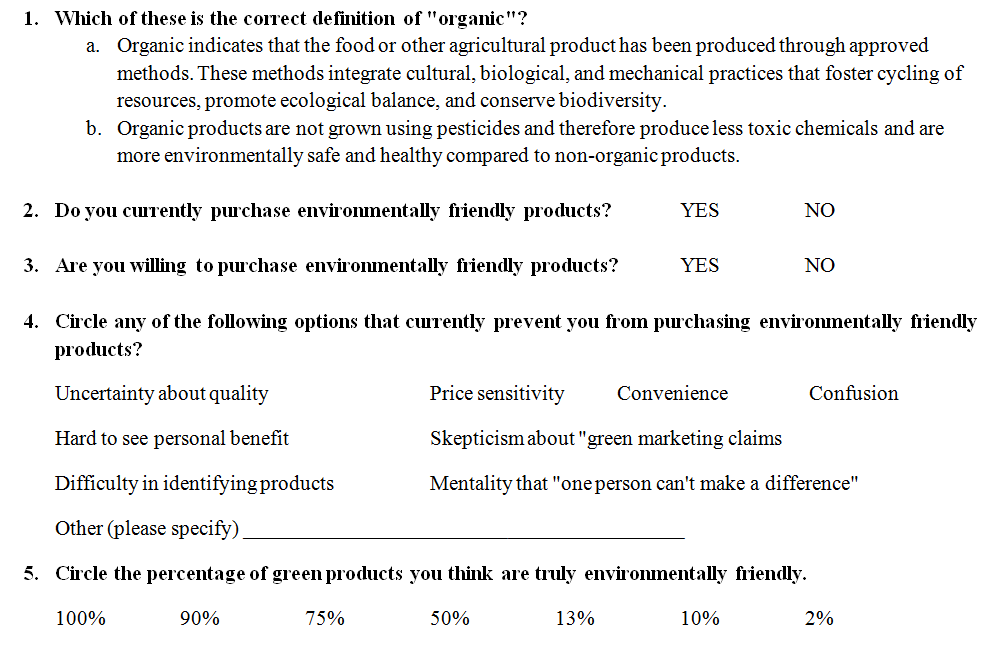
For this survey, I used a total of 25 participants that were all randomly selected and from a variety of different places. The results are as follows:
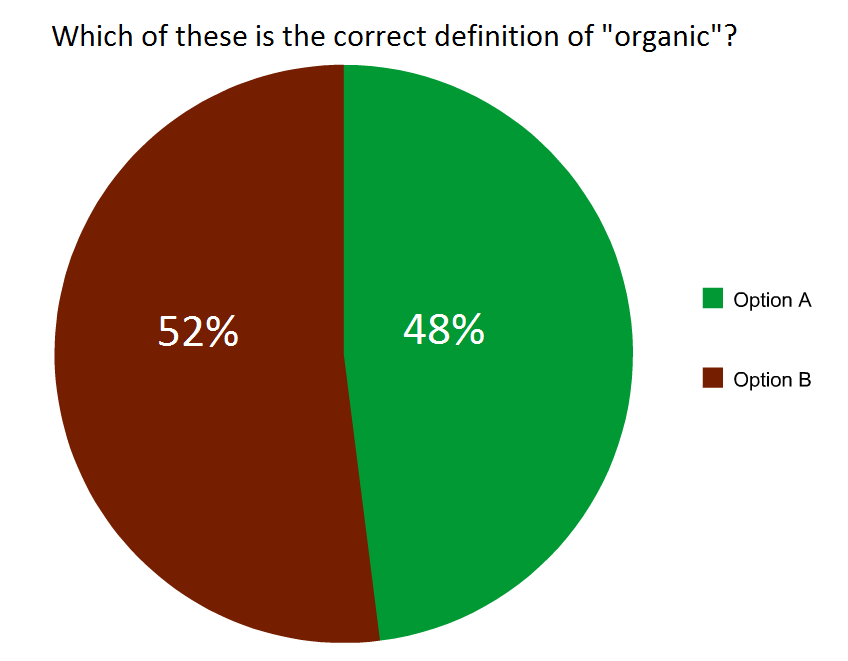
Above are the results to question one. As you can see, the results are close to even. However, the most interesting aspect of this data is that the majority of votes, although minimal, is option B, otherwise known as the wrong answer. This first question may appear obvious at first glance, but clearly the results show that over half of the participants did not know what "organic" truly means. Option A, derived from the U.S. Department of Agriculture, is actually the correct answer. Option B was an accumulation of several different stereotypes that surround what the true definition of "organic" is.
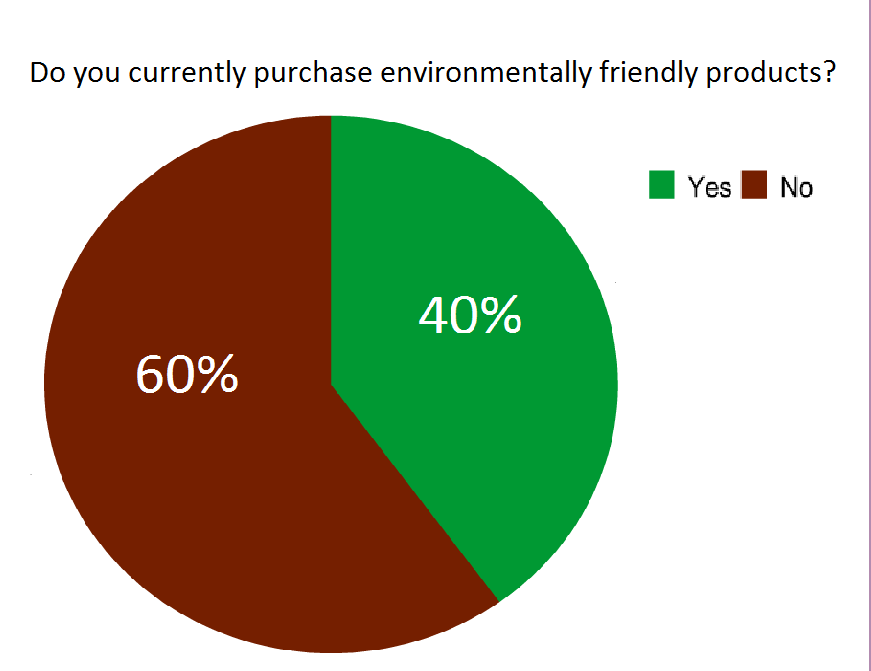
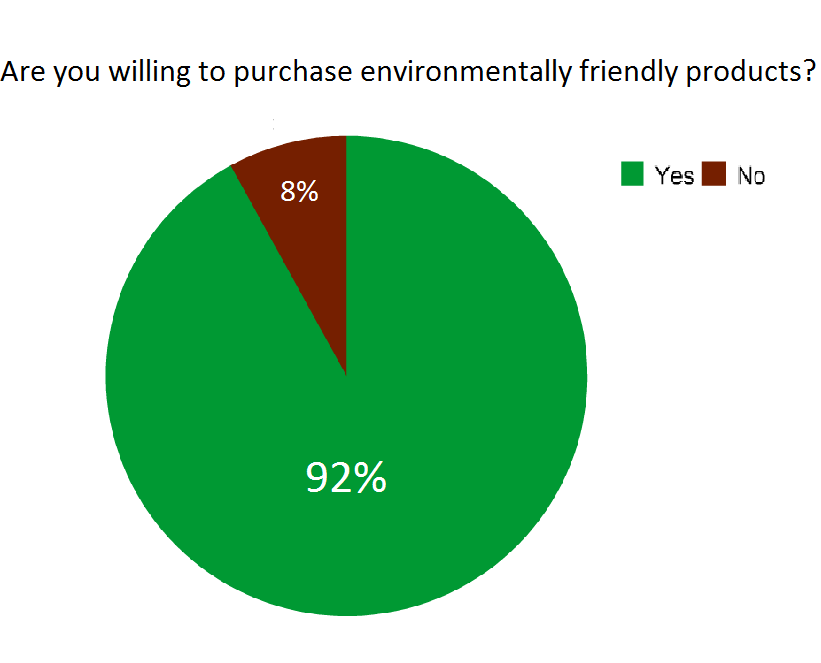
The two next pie graphs are for questions 2 and 3. The first graph aims to see approximately how many people purchase environmentally friendly products. As you can see, the majority of participants do not currently purchase green products. However, questions come to mind about the 40% who do claim to purchase Eco-friendly products. Like Diana, some of the participants could see themselves as green consumers but in actuality they are being deceived by greenwashing and other misleading advertising.
In contrast, the second graph questions whether or not participants are willing to purchase Ec0-friendly products. Clearly the majority of subjects said that they were willing to purchase green which implies that even though a majority of consumers do not buy green products that there is still an awareness of the environmental benefits that come from green products. This made me question what the possible barriers were for consumers when making the choice to purchase environmentally products. Below are the most frequent barriers that I found throughout my participants.
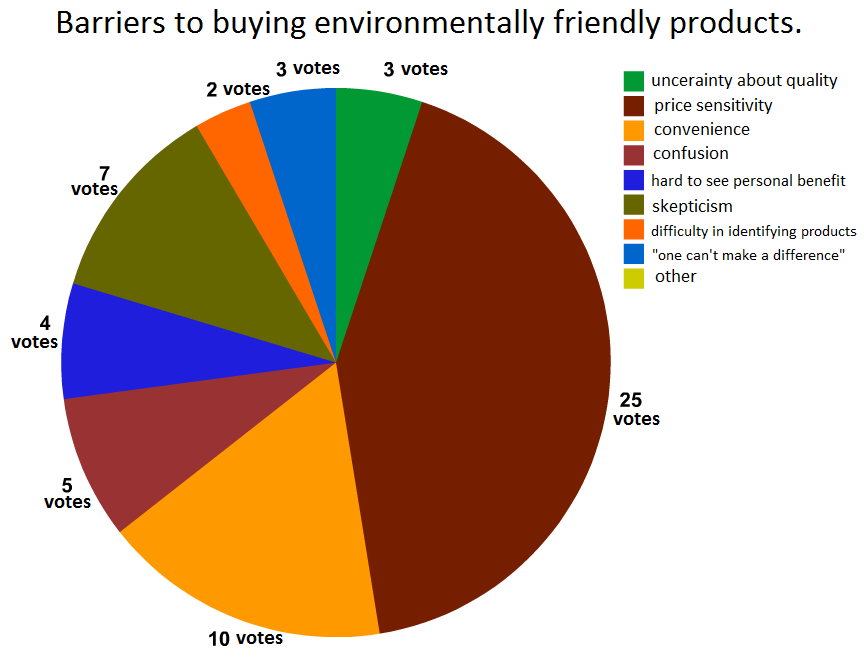
For this portion of the survey, participants were able to select all of the barriers that applied to them. As you can see, price sensitivity plays an overwhelming role in whether or not consumers buy green products. Organic foods are notoriously known for being significantly pricey and clearly this prevents consumers from purchasing green products. Other frequent barriers that I found in my survey were convenience, confusion on whether the product is reliable or really environmentally friendly (greenwashing), and skepticism. All in all, each of these barriers contribute to the overall lack of consumers buying eco-friendly products.

My last question in the survey was aimed to see how many products consumers think are actually green. In other words, how many products are truly environmentally friendly out of the products that only claim to be. It is not surprising that no one in my research thought that all products that claim to be green actually are. Nonetheless, only one person out of twenty five answered correctly: only 2% of products that claim to be green actually are. The rest of my participants most frequently responded with 50% of products being truly green, followed by 13%, then 75%.
Conclusion:
After following Diana and David Skidmore around the grocery store, I got a mere glimpse of what a self proclaimed "organic eater" shopped like. Realizing that Diana had fallen victim to false advertisments and greenwashing, my curiosity lead me to create a survey to see just how educated consumers are in the green market. With 25 participants, my results were actually very fascinating. First I discovered that the majority of participants did not even know what the true meaning of organic was yet a remaining 40% of the subjects claimed to purchase green products. I cannot help but wonder how reliable the responses are from those who claim they shop with the environment in mind, especially after observing Diana, an "organic shopper" at Publix. Regardless, question 3 which aimed to see how many participants were willing to buy green showed an overwhelming majority that consumers would buy Eco-friendly products if they were not prevented by the barriers shown in question 4. Lastly, the results of question 5 show that only one person out of twenty five knew that %2 of green products are truly green. Therefore it is not a stretch to conclude that the other twenty four, unaware of all the greenwashing in the marketing world, could be more susceptible to false green advertising.

